



If a man should wander
from his charted way
and chance upon
a thing of beauty, hidden,
then it is he
who will be rewarded;
he who will be changed.
The thing of beauty
will remain the same.
As it was before he came,
so it will be
when he is gone.
From "A Thing of Beauty" by Jim Metcalf
Introduction
During the summer of 2000, I was doing research on an abstract painter from Tennessee named Philip Perkins. I knew that in 1954 Perkins had painted a triptych for Epiphany Mission in Sherwood, Tennessee as a gift. Sometime later, a fire destroyed the church and the painting was lost. At the time, I did not know when the church had burned, whether the church had been re-built, if the church still existed, or why Perkins was compelled to paint the triptych for the church.
I happened to make contact with a man originally from Sherwood who had been a member at Epiphany. He was able to provide me with a lot of information on the church. Not only did I find information on Philip Perkins and the triptych, but I found much more. Epiphany Mission not only still existed, it had a fascinating history, and their first priest, Father George W. Jones, had a special gift for writing.
When Perkins had visited the little mission church in 1953, he was so taken by Epiphany Mission that he wanted to do something to help the church. I now understood. And I was able to help Epiphany Mission receive the half-size study of the original triptych painted by Philip Perkins so long ago.
The intent of any work of art is to inspire, to move us, to touch us, to portray a message. This is especially true when art is used in a church. But at the churches presented here, it is not so much who the artist is or whether the artists is famous that makes the work important – it is because the work provides a special link to an event or a person associated with the church or community. Such is the triptych at Epiphany Mission.
At the Church of Saint Mary of the Harbor in Provincetown, Massachusetts, it is the mural by Robert Douglas Hunter. Here Hunter has incorporated the town’s and the church’s heritage of fishermen and artists. At All Saints Church in Linville, North Carolina, it is the building itself. A rustic log structure designed by Henry Bacon and constructed of American chestnut – a wood that can no longer be found.
This link is especially strong when a church member has created the work. At the Church of the Holy Spirit in Orleans, Massachusetts, the church is filled with objects created by early church members – particularly Vernon Smith. These objects become not only something beautiful for all to enjoy but also mementos to be treasured in the hearts of the congregation for generations to come.
The beautiful objects within these churches have come to them as gifts, thank-offerings, or memorials. Ben Long wanted to create frescoes for Holy Trinity and St. Mary’s (The Parish of the Holy Communion) in the mountains of North Carolina as a gift. But there would also be a visitor to Holy Trinity who felt the church would be a better home for an object he had – a large mosaic by John Early.
Many collectors of crafts or art will say that they collect these works because they enjoy being surrounded by things that are not only beautiful, but have also been created by hand. There is a joy in having and using these objects because of the love of creating that went into their making. This is true whether a well-known artist, a family member, or a cherished friend has made the object.
Perhaps Rev. Richard Kimball, the first priest at The Church of the Holy Spirit said it best, "All of these things represent the kind of work with heart and hand that money cannot buy".
These churches take great pride in the beautiful things that they have and in their heritage. They also have a story to tell.
A while ago a visiting young man watched the congregation at a well-attended Mission Mass disband and involuntary tears wet his checks. ‘It simply gets me,’ he explained. What had touched him? He did not know. The Mass had not been a holier Mass. The priest was the average imperfect priest. The congregation had not been a more pious congregation. None of these things of themselves touched him. But what touched him was the Soul of the Mission. It was God the Life Giver.
Of the Mission there is little to see. Its priest and its people are full of imperfections. It is justly criticized. It stems few or perhaps no waves of wickedness. But almost all, up and down the valley, up and down the mountains, sooner or later feel the warmth of its Soul.
At Christmas and Easter, when death strikes, in baptism, in need and succor, some force unseen and inexplicable, is powerful and warming and winning. It is the Soul of the Mission. It is God.
— Father George W. Jones, Epiphany Mission, 1943
Dan Hardison
Co-curator
Epiphany Mission (The Old Stone Church), Dan Hardison, color woodblock print, 4" x 6", 2000